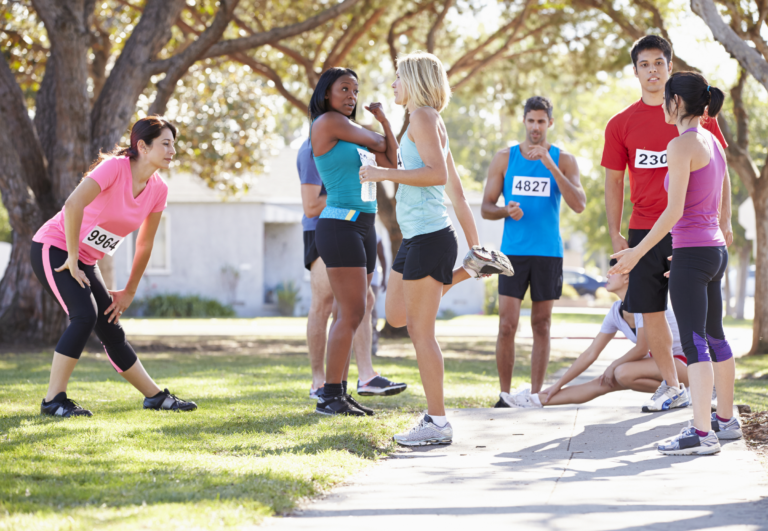Does Running Get Easier? (5 Tips for Improving Your Performance)
A runner’s high is a great feeling to achieve, but most of us have to work hard for it! Expecting to lace up your Brooks and feel a high the first time you go out for a run is just naïve. Even if you’re in shape, running presents a formidable foe. Does running ever get easier?
Running will get easier 2-4 weeks after beginning a consistent training regimen. After this time, the body will be able to use oxygen more efficiently as well as break down glycogen more effectively. More frequent runs will give your body more opportunities to adapt, and there are many strategies that yield quick but long-lasting improvements.
Read on to learn how long it takes the body to adapt to running, why running is such a difficult endeavor, when running performance declines, and some tips to make running easier!
How long does it take for your body to adapt to running?
Running is an activity that places the body under enormous amounts of physical stress with the goal of forcing the body to adapt and improve its physical performance.
How long does it generally take for the body to adapt and increase its running efficiency?
While the length of time it takes for your body to adapt to running varies based on duration, intensity, and frequency, two to four weeks is a reasonable timeline to expect substantial improvements in running performance.
According to Livestrong, two to four weeks of running results in considerable fitness improvements. Couple this with healthy eating and your body will be well on its way to prime conditioning.
While the adaptation curve is thought to be steep, the fact that the body can adapt to running in as little as two weeks is amazing! Seeing instant improvement provides unmatched motivation.
The body adapts to running quickly in two ways; VO2 max improves and glycogen utilization improves.
VO2 max is a measure of oxygen utilization. Running more makes the body more efficient at using oxygen, leading to greater oxygen supplied to muscles with less effort.
Glycogen utilization is a measure of how quickly glycogen can be broken down and used as energy. Improving the body’s use of glycogen then avoids exceeding the body’s lactate threshold (lactate threshold is the medical term for muscular fatigue).
Higher duration, intensity, and frequency will generally lead to faster adaption. The only caveat is that over-training must be avoided; otherwise, runners will experience unwanted setbacks.
Why is running hard at first?
As an athlete in my glory days, I was always in shape. Eventually, I got injured and had to hang up the cleats.
I returned to sports through running and let me tell you – the first time was not fun. Why is running so hard?
Running is hard at first because it strains your cardiovascular system further than daily aerobic activity does. The heart is not acclimated to increasing its workload, and your lungs are not properly conditioned to move extra oxygen when placed under stress.
Running is aerobic; this means that running requires oxygens, often in very large amounts. When runners run, oxygen must be moved through the body to fuel the muscle cells.
This leads to two physiological stresses:
- Increased heart rate
- Difficulty breathing from increased volume
Oxygen travels through the body within the bloodstream. To increase blood supply to muscles all over the body, the heart has to pump significantly more blood than in a resting state.
To physically intake more oxygen, runners must breathe more air. The lungs must work harder to supply the heart with oxygen to distribute to the muscles. The body must also expel increased carbon dioxide levels resulting from increased breathing.
Together, these are stressors that your body must adapt to. Over time, running trains your body to become more efficient at pumping blood and at breathing; however, the body is not conditioned at first, making running extremely taxing.
Does more running make it easier to run in the future?
The last thing a new runner wants to hear is that they need to run more to get better! However, this is no different from any other sport – practice makes the player.
Running is, at first, a real challenge for many. Does running more make running easier?
Running more decreases the difficulty of running. Increasing running frequency allows your body to adapt to the stressors that running places on your heart and lungs. It will also be less strenuous on your muscles and joints as your body adapts to the impact of running over time.
Running forces your body to adapt, specifically your heart and lungs. Like lifting weights makes your muscles stronger, and running strengthens your heart and lungs. They are muscles, after all!
Studies show that running leads to a thicker, subsequently stronger left ventricle of the heart. Increased strength in the left ventricle allows the heart to pump a higher volume of blood per beat, resulting in improved efficiency.
By increasing in efficiency, the heart does not have to work nearly as hard to maintain an aerobic state. Once adapted, runners’ heart rates are lower than the average population. Pretty impressive!
The key to adapting your body to running is frequency. One run a week will hardly make you a better runner because the body requires consistent stress.
Running three to five days a week is far superior to once or twice a week. Aim to run about every other day for the best results.
At what age does running become harder?
There’s a misconception that as we age, we become run-down, decrepit creatures, incapable of performing daily activities. This could not be further from the truth!
However, we do start to decline in terms of physical fitness. When you get out of bed in the morning, your body aches, and you lose your breath while climbing the stairs. When does running become one more thing that’s hard to do?
Running does not increase substantially in difficulty until around the age of 60. Once runners are approximately age 60, their aerobic endurance and speeds begin to decline. Physical decline, separate from aerobic activity, decreases earlier, around the age of 50.
This should come as great news for runners of all ages! Aerobic performance does not decrease as a direct result of age until about 60 years.
When age 60 is reached, endurance and speed both begin to decline. Why is this?
There are multiple reasons behind the decrease in running performance; they are natural consequences of aging and cannot be prevented, although frequent physical activity can minimize the effects of aging.
First, we typically gain weight as we age. This weight gain can be attributed to a slowdown in metabolic rate and decreased physical activity.
Metabolism slows down by a small margin, but it has the ability to add up. The average rate of metabolic slow-down is a mere 0.7% per year.
This suggests that decreased physical activity is the cause of most weight gain. Keep running and you can easily offset the effects of weight gain resulting from aging.
Another reason for decreased running performance is that our maximum heart rate and VO2 max decrease as we age.
VO2 max is the rate at which our bodies can utilize oxygen; the lower your VO2 max is, the less oxygen your body is capable of using.
Studies found that as we age, our muscles are incapable of holding the same capacity of oxygen that they were able to at a younger age. The significant decline in VO2 max can be attributed to this decreased oxidative capacity.
The effects of age are best combatted by consistent exercise. Exercise to keep the weight off and the heart strong; you won’t regret it.
Tips to make running easier
Running starts off as an immense challenge for everyone, but it doesn’t have to be that way forever.
It is possible for new runners to build a substantial aerobic base to improve their running performance. Some of the following tips will help with increasing cardiovascular fitness, whereas some are general recommendations to improve running conditions:
- Progress slowly
- Run for time instead of distance
- Get high-quality sleep
- Run in the morning or evening
- Use the run/walk strategy
I can vouch for these tips; throughout my running experience, I have used every single one of the following strategies. They have helped me evolve into the runner I am today!
I highly recommend you give them a try and watch as the world of running unfolds before your eyes.
Progress slowly
While runners may be gung-ho to hit the road or trails and start running, it’s actually better to take a slow approach to running. The tortoise beat the hare, after all.
Progress slowly when you begin running. The general recommendation to develop the cardiovascular system while also avoiding injury is to increase running volume by no more than 10% per week.
As a complete beginner, 10% can be too conservative of a number but the point stands the same: ease into running.
Runners achieve gradual conditioning by increasing running volume in small increments while avoiding serious injury.
Small incremental increases allow muscles and joints to adjust to the new wear and tear on the body. Any more than a 10% increase in a week and you put yourself at risk for injuries like shin splints or worse.
The 10% rule helps build an aerobic base as well. Most aerobic base training plans, which are the foundations for a great runner, recommend only increasing volume by 5 to 10% per week.
It’s clear that slow progression beats overload, so move slowly and be patient. The running will get easier.
Run for time instead of distance
New runners tend to shoot for distance when planning runs. I’ll run 2 miles today, 3 miles next time, etc. What if I told you there’s a better way to plan runs and see progress?
Rather than planning runs in terms of distance, aim to run for a certain length of time. Running for time allows you to adjust your pace as necessary; you can listen to your body and understand cues instead of pushing to reach your mileage marker.
A key benefit of running for time is that it results in a lower perceived effort on the part of the runner. You run based on how you feel, which is super important for new runners.
To become a better runner, it’s essential to understand our bodies and what they’re telling us. Running for time allows runners to develop that connection.
You can adjust the pace when running for time; as long as you run for the allotted amount of time, it doesn’t matter the pace. All that matters is you ran till the time was up.
The flexibility of running for time cannot be understated for new runners. It’s more enjoyable too, meaning runners will be more consistent. At the end of the day, consistency is king.
Get high-quality sleep
A good night’s sleep is one of the best things a runner can do for their performance and their overall health. Sleep recharges the body and gives runners the energy to take on the trails.
Sleeping allows your body to repair and re-energize; runners may be left lethargic and achy without sleep.
Sleep is crucial to human life. Sleep repairs the body and clears neural pathways for clear thought and memories. What would we do without it?
Suffer! When runners don’t get enough sleep, their bodies can’t heal. As a new runner, allowing your body to heal from the stress you’ve introduced is crucial!
Get a good night’s rest to feel energized and in tip-top shape. The practical recommendation is to sleep 7-9 hours a night while following sleep hygiene practices: don’t eat large meals before bed, turn off blue lights, etc.
Run in the morning or evening
Running in the heat of the day is a cardinal sin in running. Instead, opt to run in the morning or evening for a more enjoyable experience.
Run in the morning or evening to avoid high temperatures and subsequently higher exertion.
Higher temperatures create fatigue in runners much more quickly than moderate temperatures.
For example, running at 77°F requires 4.5% more energy when compared to running at 41°F, assuming the same pace.
Fifty degrees is the optimal temperature for runners; it’s not so cold that runners must spend miles warming up, but it won’t fatigue runners either.
By running in the morning or the evening, runners will experience much more temperate weather and will therefore receive better returns on the energy they expend.
Use the run/walk strategy
To get your foot in the door, alternate between running and walking. There’s no shame in walking; the method was created by a former Olympic runner named Jeff Galloway!
Use the run/walk method to improve aerobic endurance slowly. Alternating between running and walking helps runners build running stamina while decreasing the risk of injury.
The run/walk method is a basic form of interval training where runners alternate between running and walking.
The ratio of running to walking depends on the individual; the more fit a runner is, the more running they should be able to complete.
By alternating between low-intensity running and walking breaks, the overall length of exercise can be greatly increased. It’s sustainable over all else.
The run/walk method is perfect for beginners because it allows them to transition into running without feeling intensely challenged or burnt out.






